

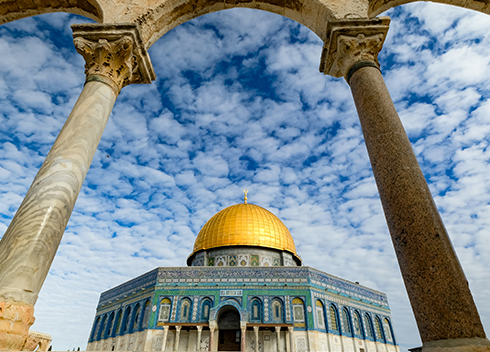
The meaning of the name ‘Masjid al-Aqsa’ is ‘the farthest mosque’ and to Muslims is the third most holiest place in Islam. This mosque is well known for the visit of Prophet Muhammed(PBUH.) in 621 CE. This visit is known as the night journey from Makkah, riding on the Buraq.
Masjid al-Aqsa is a very special masjid. The Prophet (PBUH) on many occasions explained to the Sahabah (Companions) to appreciate the excellent qualities of Masjid al-Aqsa. Here are some of the reasons why Masjid al-Aqsa should form an important place in the heart of a believer:
The first qiblah (direction of prayer) for Muslims.
The station of al-Isra and al-Mi’raj.
The second house of Allah built on earth.
The place where hundreds of Messengers of Allah (swt) are buried.
The place where many Sahabah are buried.
A place where miracles by the will Allah (swt) were shown.
A place Allah (SWT) Himself calls a ‘blessed place’.
Directly and indirectly referenced in the Quran 70 times
A place where angels have descended with Allah’s message.
The only place on earth where all the Messengers of Allah prayed at the same time led by Prophet Muhammed (pbuh).
The only Masjid mentioned by name in the Quran apart from the Ka’bah.
Tailor made packages to fulfil all your needs and desires
contact us for a no obligation quote
Land at Tel Aviv Airport.
Once immigration is cleared, check into hotel, have dinner and rest overnight.
Tahujjud & Fajr prayer at Masjid Al Aqsa
1- Jabal Al Makuber
Where Khalifa Omar Ibn Al Khattab (RA). said Allahu Akbar once he saw Bait Al Maqdes
2- City of Hebron in Palestine
Where we will visit the tombs of the prophets (Ibrahim, Ihaq, Yusuf, Jakob AS)
And their wives (Sarah, Leah ,Rebecca AS)
3- Maqam Nabi Younus
In the city of Halhul where Nabi Younus stayed for one year before being swallowed by the whale
Tahujjud & Fajr prayer at Masjid Al Aqsa and Jumu’ah prayers
1- Masjid Omar bin Al khattab
In the old city of Baitul Maqdes
Where Omar (RA) prayed opposite the church of the holy sepulchre where Christians believed Nabi Issa as was buried
2- Holy sepulchre church in the old city according to the Christians is where Nabi Isa as was crucified, buried and resurrected after 3 days
3- Aqsa mosque which is a complex of 144000 square meter that consists of 5 mosques(Dome of the Rock, Qibli, Marwani, Buraq, Old mosque)
After breakfast
1- Mount of Olives 820 meters above sea level
Considered a holy mountain for three religions
2- Maqam Salman Alfarsi who is one of Sahabat Rasul Allah (SAW)
3- Maqam Rabiah Aladawiyah
A woman from the Abbasi period was considered as a religious woman known as the founder of Mazhab Alsoufi
4- Jericho the oldest and lowest city in earth 9000 years old and 320 meters below sea level
5- Dead sea 33 salinity
Lowest sea on earth 417 meters below sea level, located next to where The tribe of Nabi Lut was cursed
6- Maqam Nabi Musa (AS)
Built by Salah Ladin alayubi after defeating the crusaders 1178
Check out from the hotel –
After breakfast
1- Maqam Nabi Dawood (AS)
Was built by the crusaders and today is used by the Jewish as a synagogue
2-Lud city south of Tel Aviv
Maqam Aldajal
Where Nabi Issa (AS) is foretold to kill the Dajjal
3-Jaffa city
Where Masjid Mahmoudyah an Ottoman mosque was built in the 19th century
And Hasan Baik mosque another Ottoman mosque are located
Departure to Ben Gorion airport.
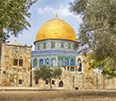
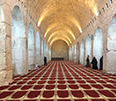
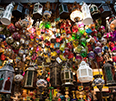
Jerusalem, a Middle Eastern city west of the Dead Sea, has been a place of worship for Muslims since the biblical era. Its Old City has significant religious sites around the Temple Mount compound, including the Western Wall, the Dome of the Rock (a 7th-century Islamic shrine with a gold dome).
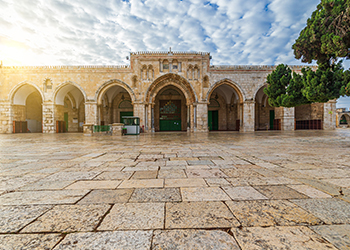
Masjid Al-Aqsa is also known as Bayt al-Muqaddas. In Islam it is the third holiest site in Islam and is located in the Old City of Jerusalem. In the past the entire site on which the silver-domed mosque sits, with the Dome of the Rock, the seventeen gates and four minarets, was itself known as the Al-Aqsa Mosque, today a more separate definition is used, The wider compound is commonly known as al-Haram ash-Sharif ("the Noble Sanctuary"), or the Temple Mount, the holiest site in Judaism. It is the belief of Muslims that Prophet Muhammad (PBUH) was transported from the Sacred Mosque in Makkah to al-Aqsa during the Night Journey. Islamic history states Prophet Muhammad (PBUH) led prayers towards this site until the seventeenth month after the emigration, when Allah (SWT) directed him to then pray towards the Kaba.
Originally, the mosque was a small prayer house built by the Rashidun caliph Umar, but was rebuilt and expanded by the Umayyad caliph Abd al-Malik and finished by his son al-Walid in 705 CE. The mosque was completely destroyed by an earthquake in 746 and rebuilt by the Abbasid caliph al-Mansur in 754. His successor al-Mahdi rebuilt it again in 780. Another earthquake destroyed most of al-Aqsa in 1033. Two years later the Fatimid caliph Ali az-Zahir built another mosque which is the mosque that we are blessed to see today.
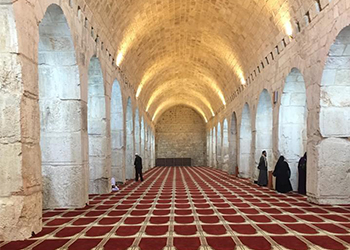
The Marwan-e-Masjid is a praying area that is underground and located on the south-east side of the al-Aqsa compound. This area has recently been restored. When the Crusaders had control of the mosque they used to use this area as stables for their horses and it became known as Solomon’s stables.
Although this site is traditionally known as ‘Solomon’s stables’, the original building is unlikely to date as far back as Prophet Sulaiman (upon him be peace) and can more plausibly be attributed to Herod the Great who substantially extended the Temple Mount platform during his reign.
Many of the columns have holes that were made by the Crusaders to thread rope to tie their horses. It is estimated that 400 horses were kept here at one time.
Islamic history credits a caliph named Marwan I with transforming this area of the vaults into a series of usable rooms, rather than just going down to the bedrock directly. The location had originally been intended to be made into a mosque (which is thus known as the Marwani mosque). In 1996, the Palestinian Waqf converted the area (during crusader times had been mostly empty) into a modern mosque, capable of housing 7,000 people.
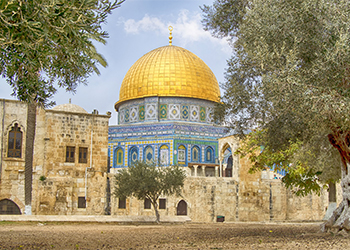
Located in Jerusalem, the Dome of the Rock Is a 7th-century historic structure. It enshrines the rock from which Prophet Muḥammad (PBUH) is said to have ascended to heaven. The Dome of the Rock is an amazing masterpiece of Islamic architecture. It was also the first domed shrine to be built.
The Byzantine design, octagonal plan and the rotunda dome of wood are what make it a sight that needs to be seen. The Persian tiles on the exterior and the marble slabs that decorate the interior were added by Suleiman I in 1561.
The site's importance stems from religious traditions regarding the rock, known as the Foundation Stone, at its heart, which bears great significance for Jews and Muslims as the site of Abraham's attempted sacrifice of his son (Isaac according to Genesis 22:2, Ishmael according to Islamic belief.)
It has been known as "Jerusalem's most recognizable landmark," and it is a UNESCO World Heritage Site, along with two nearby Temple Mount structures, the Western Wall, and the "Resurrection Rotunda" in the nearby Church of the Holy Sepulchre
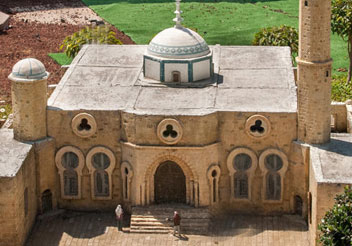
Located in Jaffa and known also as the Hasan Bey Mosque, It is considered to be one of the most well-known mosques in Jaffa, which is now part of the Tel Aviv-Yafo municipality in Israel. The Hassan Bek Mosque was built in 1916, by Jaffa’s Turkish-Arab governor of the same name. At the time, Arab Jaffa and the recently founded Jewish Tel Aviv were both competitively expanding and seeking to block each other; the mosque was part of Manshiyya, Jaffa's northern most neighborhood which spread northwards along the Mediterranean seashore.
The governor of Jaffa who had the mosque built is named as Hassan Bey or Bek. Hassan Bey headed Jaffa between August 1914 and May 1916. The mosque was built on a plot of land selected and confiscated by Hassan Bey from its Arab Christian owner, which he re-registered in his own name. On his orders, building materials were plundered from construction sites in the area, and the work force consisted of people, mainly Muslims, grabbed by force from the streets.
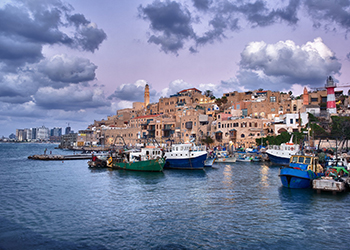
Jaffa is also known as Japho or Joppa and is in the southern and oldest part of Tel Aviv, Jaffa is an ancient port city in Israel. Jaffa is famous for its association with the biblical stories of Jonah, Solomon and Saint Peter as well as the mythological story of Andromeda and Perseus.
The tell of Jaffa rises to a height of 40 meters (130 ft), with a broad view of the coastline, giving it a strategic importance in military history. The accumulation of debris and landfill over the centuries made the hill even higher. Archaeological evidence shows that Jaffa was inhabited roughly 7500 BCE. Jaffa is mentioned in an Ancient Egyptian letter from 1440 BCE, glorifying its conquest by Pharaoh Thutmose III, whose general, Djehuty hid armed Egyptian warriors in large baskets and sent the baskets as a present to the Canaanite city's governor.
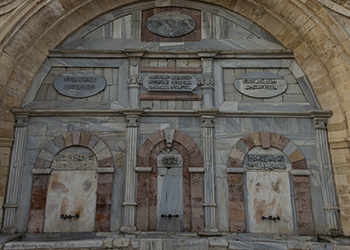
Is the largest and most significant mosque in Jaffa, now part of the larger city of Tel Aviv. It is composed of a complex of buildings arranged around two large courtyards and a third, smaller, courtyard. During Ottoman rule in souther Syria the buildings, gates, and courtyards were built at different stages throughout the 18th and 19th centuries.
By the orders of Governor Sheikh Muhammad al-Khalili the Mahmoudiya Mosque construction is said to have started in 1730. A sabil (fountain), located in the southern wall of the mosque, is attributed to Sulayman Pasha, who was a governor of the Acre in the late 18th and early 19th centuries.
Most of the mosque we see today was built in 1812 by the Ottoman governor of Gaza and Jaffa, Muhammad Abu-Nabbut. The main courtyard, located in the western part of the mosque, with its arcades and large rectangular prayer hall covered by two big shallow domes, and with its slender minaret are accredited to the same governor. Previous construction is hardly visible if you visit today. Research has shown that Abu-Nabbut's mosque was built on the foundations of a smaller mosque that belonged to the Bibi family of Jaffa. The building still has Roman columns from Caesarea and Ashkelon.
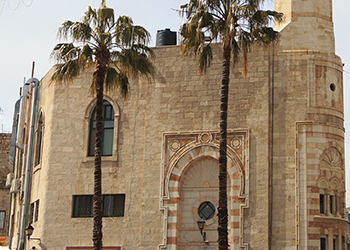
The mosque is named after Omar (Umar) ibn al-Khattab (c. 581–644), the second Rashidun Muslim Caliph. After conquering Jerusalem, Omar ibn al-khattab had traveled to Bethlehem in 637 CE to issue a law that would guarantee respect for the shrine and safety for Christians and clergy. Four years after the passing of the prophet Muhammad (PBUH), Omar was said to have prayed at the location of the mosque. The mosque was built in 1860 but was not renovated until 1955, during Jordanian control of the city. The land used for its construction was donated by the Greek Orthodox Church. In the past, before the introduction of light bulbs, it was common for Muslims and Christians in Bethlehem to offer olive oil to light up the surroundings of the mosque, proof of religious coexistence in the city.
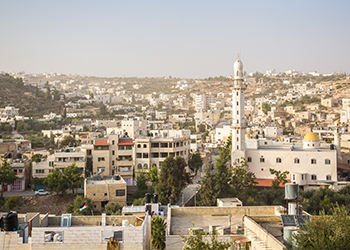
Hebron is a Palestinian city located in the southern West Bank, 30 km south of Jerusalem. Nestled in the Judaean Mountains, it lies 930 meters above sea level.
Hebron is known for being a busy hub of trade in the West Bank, responsible for roughly a third of the area's gross domestic product, mainly due to the sale of marble from local quarries. The area is also well known for its grapes, figs, limestone, pottery workshops and glassblowing factories, and is the location of the major dairy product manufacturer, al-Junaidi. The old city of Hebron is known for its narrow, winding streets, flat-roofed stone houses, and old bazaars. Hebron University and the Palestine Polytechnic University are both located in this well known city.
The cities of ad-Dhahiriya, Dura, Yatta, the surrounding villages with no borders are all attached to the city of Hebron. Hebron Governorate is the largest Palestinian governorate with its population of 600,364 (2010).
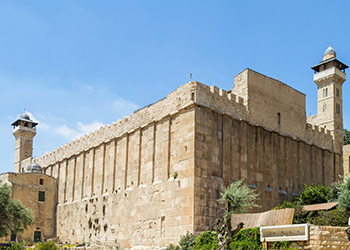
In Islam Al Haram Al Ibrahimi is thought to be the fourth holiest site , Al-Haram Al-Ibrahimi (Sanctuary of Abraham) or Tomb of the Patriarchs is one of the main features of the city of Hebron. This 1000-year old mosque enshrines the tombs of prophets Abraham "Ibrahim", Isaac "Is'haq", Jacob (pbuh), and their wives. It is believed that prophet Mohammad (pbuh) visited it on his night flight from Makkah to Jerusalem. The structure looks to date back from 1500 BC though Herod probably built the huge wall around it. This site has been changed by successive ruling groups from a cave to the massive structure that it is today, as well as from a church, mosque and synagogue. It is also the site of maqams for Siti Sara, SitiRifkah and SitiLeah, SidiYousef and Sidi Ibrahim.
According to Arab legend, the massive stones of the walls built without mortar, were laid by King Solomon (pbuh) with the help of Genies or spirits. The construction of the walls and the pavement of the Haram, however, bear the unmistakable stamp of Herod the Great. Additional Crusader and Mamluk structures combine to make it one of the most impressive ancient monuments in the West Bank outside of Jerusalem.
The Haram is a parallelogram, is 65m long, 35m in width, built of large drafted ashlars, similar to those in Al-Haram El-Sharif in Jerusalem. Standing 15m high, it is the work of Herod the Great. The crenellated upper part of the wall is of Mamluk origin. In the past it was surrounded by 4 square minarets, of which only those at the northeast and northwest corners remain.
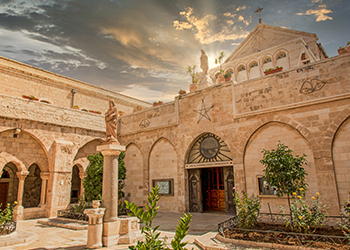
The Nativity Church is well known for as the birth place of Prophet Issa. The Church of Nativity is a basilica located in Bethlehem, West Bank. The church was originally commissioned in 327 by Constantine the Great and his mother Helena over the site that was traditionally considered to be located over the cave that marks the birthplace of Jesus. The Original basilica of the Church of the Nativity was completed in 339 and destroyed by fire during the Samaritan Revolts in the 6th century. A new basilica was built in 565 by Justinian, the Byzantine Emperor, restoring the architectural tone of the original. The site of the Church of the Nativity has had numerous additions since this second construction, including its prominent bell towers. Due to its cultural and geographical history, the site holds a prominent religious significance to those of both the Christian and Muslim faiths.
The site of the Church of the Nativity is a World Heritage Site, and was the first to be listed under Palestine by the United Nations Educational, Scientific and Cultural Organization (UNESCO). The site is also on UNESCO's List of World Heritage in Danger.
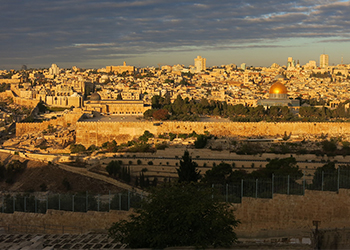
The Mount of Olives or Mount Olivet is a mountain ridge east of and adjacent to Jerusalem's Old City. It was given this name due to the olive groves that once covered its slopes. Also known for its Panoramic view of the Old City of Jerusalem. The southern part of the Mount was the Silwan necropolis, attributed to the ancient Judean kingdom. The Mount has been used as a Jewish cemetery for over 3,000 years and holds approximately 150,000 graves, making it central in the tradition of Jewish cemeteries. Based on the gospels many key events in the life of Jesus, took place on the Mount of Olives, and in the Acts of the Apostles it is described as the place from which Jesus ascended to heaven. Due to this historical and spiritual link with both Jesus and Mary, the Mount has been a site of Christian worship since ancient times and today is a major site of pilgrimage for Catholics, the Eastern Orthodox, and Protestants.
The Mount of Olives is one of three peaks of a mountain ridge which runs for 3.5 kilometres (2.2 miles) just east of the Old City across the Kidron Valley, in this area called the Valley of Josaphat. The peak to its north is Mount Scopus, at 826 metres (2,710 feet), while the peak to its south is the Mount of Corruption, at 747 m (2,451 ft). The highest point on the Mount of Olives is At-Tur, at 818 m (2,684 ft). The ridge acts as a watershed, and its eastern side is the beginning of the Judean Desert.
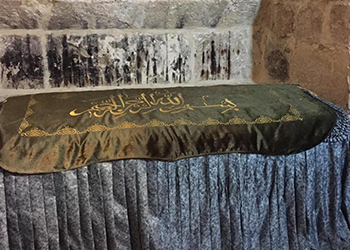
A woman said to have been born between 714 and 718 CE (95 and 98 Hijri) in Basra, Iraq of the Qays tribe. much of Rābiʻas early life has been recounted by Faridud-Din Attar, a later Sufi saint and poet. She herself left no written works about her life. She was the fourth daughter of her family and therefore named Rābiʻa, meaning "fourth". Although not born into slavery, her family was poor yet respected in the community.
Often noted as having been the single most famous and influential renunciant women of Islamic history, Rābiʻa was remembered for her extreme virtue and piety. when asked why she performed a thousand ritual prostrations both during the day and at night, she answered: "I desire no reward for it; I do it so that the Messenger of God, may God bless him and give him peace, will delight in it on the day of Resurrection and say to the prophets, 'Take note of what a woman of my community has accomplished'
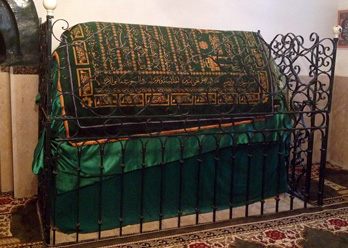
Salman the Persian or Salman al-Farsi, born Rouzbeh, was a companion of the Prophet Muhammad (PBUH) and the first Persian who converted to Islam. He was raised as a Zoroastrian, then attracted to Christianity, and then converted to Islam after meeting prophet Muhammad (pbuh) in the city of Yathrib, which was later called Medina. He was referred to as Abu Abdullah by sahabah in his later years. He is credited with the idea of digging a trench around Medina when it was attacked by Mecca in the Battle of the Trench. He was appointed as the governor of Al-Mada'in in Iraq. According to popular Shia tradition, Muhammad considered Salman as part of his household (Ahl al-Bayt). He was a renowned follower of Ali ibn Abi Talib after the death of Muhammad.
Salman was a Persian born in either the city of Kazerun in Fars Province, or Isfahan in Isfahan Province, Persia. Salman also traced his ancestry to Ramhormoz. The first sixteen years of his life were devoted to studying to become a Zoroastrian magus or priest after which he became the guardian of a fire temple, which was a well-respected job. Three years later in 587 he met a Nestorian Christian group and was so impressed by them. Against the wishes of his father, he left his family to join them. His family imprisoned him afterwards to prevent him but he escaped.
-new.jpg)
This wall previously used to be called the ‘Wailing Wall’ and is now referred to as the ‘Western Wall’ is the most sacred place for Jews who believe it to be the only surviving structure of the Herodian temple. Muslims know this wall as the Buraq Wall, because on the other side is where the Prophet Muhammed (PBUH) tied the Buraq, the winged riding animal upon which he rode during the Night of Ascension.
The current plaza occupies an area that used to be residential housing called the Maghribi (Moroccan) Quarter. It was endowed by Al-Afdal, the brother of Salahuddin Ayyubi so that aid and services could be provided for North African pilgrims and the poor; he also built a madrasah (seminary) where the fiqh (jurisprudence) of the Maliki school of thought could be taught and studied. During the Mamluk period, madaris (seminaries) had been built all along this wall, except for a stretch of about 22 meters between the Street of the Chain (Tariq al-Silsila) and the Maghribi Gate.
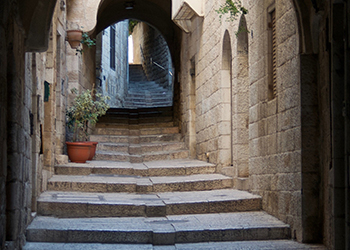
The Old City is a 0.9 square kilometers walled area within the modern city of Jerusalem. Until 1860, when the Jewish neighborhood Mishkenot Sha'ananim was established, this area constituted the entire city of Jerusalem. The Old City is home to several sites of key religious importance: the Dome of the Rock and al-Aqsa Mosque for Muslims, the Temple Mount and Western Wall for Jews and the Church of the Holy Sepulchre for Christians, It was added to the UNESCO World Heritage Site List in 1981.
The Old City is now roughly divided into the Muslim Quarter, Christian Quarter, Armenian Quarter and the Jewish Quarter. The Old City's monumental defensive walls and city gates were built in the years 1535-1542 by the Turkish sultan Suleiman the Magnificent. The current population of the Old City resides mostly in the Muslim and Christian quarters.
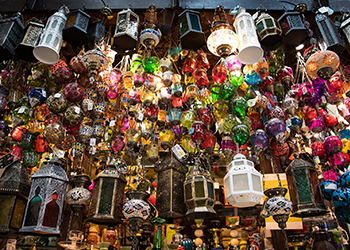
The Suqk is a marketplace (originally open-air, but now at least partially covered) in Jerusalem. It is very popular for locals and tourists, the markets have more than 250 vendors. They sell fresh fruits and vegetables; baked goods; fish, meat and cheeses; nuts, seeds, and spices; clothing and shoes; and housewares, and textiles.
There is also food markets selling falafel, shawarma, kibbeh, kebab, shashlik, kanafeh, baklava, halva, zalabiya and Jerusalem mixed grill stands, juice bars, cafes, and restaurants. The mesmerizing colors and buzzing of the marketplace is accentuated by vendors who call out their prices to passersby. On Thursdays and Fridays, the marketplace is filled with shoppers stocking up for Shabbat, until the Friday afternoon sounding of the bugle that signifies the market will close for the Sabbath.
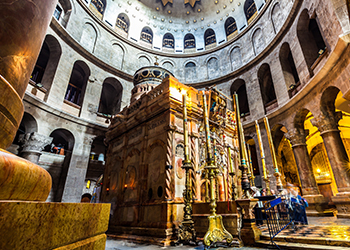
The Church of the Holy Sepulchre is situated in the Christian Quarter of the Old City of Jerusalem, a short distance away from the Muristan. The church is said to date back to at least the fourth century. The two holiest sites in Christianity: the site where Jesus of Nazareth was crucified, known as "Calvary", and Jesus's empty tomb, where he is said to have been buried and resurrected. The tomb is enclosed by the 18th-century shrine, called the Edicule (Aedicule).The church has been a major Christian pilgrimage destination since its creation in the fourth century, as the traditional site of the Resurrection of Christ, thus its original Greek name, Church of the Anastasis.
Today the wider complex accumulated during the centuries around the Church of the Holy Sepulchre also serves as the headquarters of the Greek Orthodox Patriarch of Jerusalem, while control of the church itself is shared between several Christian denominations and secular entities in complicated arrangements essentially unchanged for over 160 years, and some for much longer.